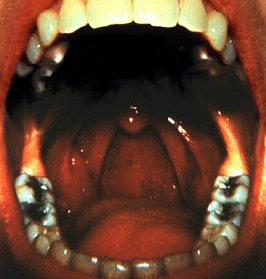Older Men at Higher Risk of Persistent Oral HPV Infection
An infection with oral HPV16 is likely to last for a year or longer in older men, putting them at higher risk for the development oropharyngeal cancer.
Soft palate and oropharyngeal tissues

An infection with oral human papillomavirus 16 (HPV16) is likely to last for a year or longer in older men, putting them at higher risk for the development of oropharyngeal cancer, according to the results of a study published in Cancer Prevention Research.
Christine M. Pierce Campbell, PhD, MPH, of the Center for Infection Research in Cancer at the Moffitt Cancer Center in Tampa, Florida, and colleagues evaluated 1,626 men who were part of the HPV Infection in Men (HIM) study. Presence of HPV16 infection was evaluated by collecting oral gargle samples from the participants at enrollment, and then every 6 months for 4 years.
Twenty-three of the men (median age of 36) were positive for HPV16. Of the 23 HPV16-positive men in the study, those older than 45 years of age were more likely to have longer lasting infections (P = .023).
Participants in the study were evaluated for a median of 44.4 months. The viral infections persisted as long as 4 years in some men. While HPV infections in genital tissue usually clear within about 2 years, the current study suggests that oral HPV infections may be more likely to stick around longer.
Ten men had infections at the initial study sample collection, with nine of these infections lasting for more than 1 year, eight lasting for more than 2 years, four lasting for more than 3 years, and two lasting for more than 4 years.
Of the thirteen men who had so-called incident infections (detected during the course of the study), four of these infections persisted for longer than 1 year, one for more than 2 years, with none lasting more than 3 years.
Oral HPV16 is the most common type of HPV that causes oropharyngeal cancer, and according to the 2013 Annual Report to the Nation on the Status of Cancer by the American Cancer Society, there has been a significant uptick in the incidence of these HPV-positive oral cancers in men in the last 20 years. The number of yearly cases of oropharyngeal cancers reported among men is now greater than the number of cervical cancer cases.
“Understanding patterns of oral HPV persistence is essential in the development of HPV-driven oropharyngeal cancer prevention and early detection strategies,” wrote the authors in their discussion.
Unlike the Papanicolaou (Pap) test for cervical cancer screening, there are not current methods to detect precancerous lesions of the head and neck. “Long-term persistence of high-risk genital HPV infection is the strongest predictor of cervical pre-cancer and cancer development in women.” Previous research has shown that of all the high cancer risk HPV subtypes, HPV16 persists the longest and confers the highest risk of precancerous lesions.
“With a constant rate of acquisition of new oral HPV infections and higher likelihood of persistence with age, mid-adult and older men appear to be at the highest risk of oral HPV infection and should be the focus of prevention interventions,” concluded the authors.
The study was funded by Merck Sharp & Dohme, the American Cancer Society, and the National Cancer Institute Intramural Research Program.